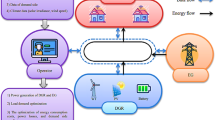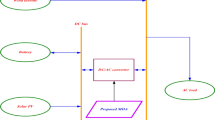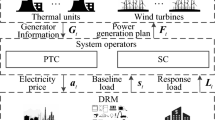Abstract
Flexible AC transmission systems (FACTS) devices have advantages of enhancing AC system controllability and stability, increasing power transfer capability and relieving congestion. Finding the best sizing and siting of them is obligatory to obtain the maximum benefit. In this paper, the optimum planning is done for determining the suitable sizing and siting of the FACTS devices during their lifetime span. The proposed planning approach is implemented to the networks, which are suffering from the contingency to demonstrate that how proper sizing and siting of the FACTS devices are able to deal with the existing problems in such networks. In fact, the maximum social welfare, reducing load shedding cost and construction cost of the new branches besides of the technical issues such as voltage improvement are the main concerns of the present work. To accomplish these aims accurately and reduce the computation time, a hybrid approach, consisting of mathematical and heuristic methods, is proposed for solving the proposed planning problem. The mentioned algorithm is a combination of biogeography-based optimization (BBO) as a heuristic algorithm and nonlinear programming as a mathematical approach. Furthermore, since the stochastic natures of renewable energy sources and load variations contribute to the optimum decisions, the stochastic formulation has been considered in the planning problem using the efficient point estimation (\( 2m + 1 \)) scheme. Finally, the proposed planning approach is tested on different test systems, namely IEEE 14-bus, IEEE 57-bus and IEEE 300-bus, in order to verify its effectiveness from a different point of views.









Similar content being viewed by others
Abbreviations
- l :
-
Index for load
- n, m :
-
Indices for node
- g :
-
Index for generator
- h :
-
Index for hour
- y :
-
Index for year
- s :
-
Index for scenario
- f :
-
Index for FACTS devices
- j :
-
Index for uncertain variable in (\( 2m + 1 \)) scheme
- \( \omega \) :
-
Index for habitat
- \( \varphi \) :
-
Index for SIV in each habitat
- iter:
-
Index for iteration
- NPV:
-
Index for net present value of the variable
- FACTS:
-
State with FACTS devices
- NOFACTS:
-
State without FACTS devices
- exp:
-
Superscript for expected value of the variable
- Max:
-
Superscript for maximum amount of the variable
- Min:
-
Superscript for minimum amount of the variable
- new:
-
Superscript for updated variable
- BBO:
-
Biogeography-based optimization
- \( A,B \) :
-
Shape and scale of the Weibull distribution
- \( P_{\text{wr}} \) :
-
Rated power of the wind
- a, b, c :
-
Coefficients of bid function of the interruptible loads
- \( v_{\text{i}} \) :
-
Cut-in speed
- \( v_{\text{r}} \) :
-
Rated speed
- \( v_{\text{o}} \) :
-
Cut-out speed
- \( N_{\text{TCSC}} \) :
-
Number of the TCSC
- \( N_{\text{SVC}} \) :
-
Number of the SVC
- \( N_{\text{scen}} \) :
-
Number of the scenarios
- \( n_{G} \) :
-
Number of the generators
- \( n_{l} \) :
-
Number of the load
- \( n_{\text{lifetime}} \) :
-
Lifetime of the FACTS devices
- rate:
-
Rate of interest
- \( {\text{price}}^{\text{shed}} \) :
-
Price of the load shedding ($/MW)
- \( L_{\text{int}} \) :
-
Set of the interruptible load
- \( \alpha \) :
-
Fixed coefficient in BBO algorithm
- \( v \) :
-
Velocity of wind
- \( P_{w} \) :
-
Wind output power
- \( P_{g} \) :
-
Generator output active power (MW)
- \( Q_{g} \) :
-
Generator output reactive power (MW)
- \( P^{\text{load}} \) :
-
Active load in each node (MW)
- \( Q^{\text{load}} \) :
-
Reactive load in each node (MW)
- \( P^{\text{fc}} \) :
-
Forecasted active power in each node (MW)
- \( P^{\text{shed}} \) :
-
Active shed power in each node (MW)
- \( C_{\text{Gen}} \) :
-
Cost function of the diesel generator
- \( {\text{Cost}}_{\text{TCSC}} \) :
-
Investment cost of the TCSC per kVAr
- \( {\text{Cost}}_{\text{SVC}} \) :
-
Investment cost of the SVC per kVAr
- \( {\text{Cost}}_{\text{Install,FACTS}} \) :
-
Total investment cost of the FACTS devices
- Ben:
-
The obtained benefit of the TRANSCO
- \( S_{\text{SVC}} \) :
-
SVC capacity in MVAr
- \( S_{\text{TCSC}} \) :
-
TCSC capacity in MVAr
- Bid:
-
Interruptible load bid
- V :
-
Voltage magnitude of each node
- \( I^{\text{line}} \) :
-
Line current
- prob:
-
Probability of each scenario
- lmp:
-
Locational marginal price ($/MW)
- \( \chi \) :
-
Location of the particular concentration in (\( 2m + 1 \)) scheme
- \( \xi \) :
-
Standard deviation of the particular variable
- \( \lambda \) :
-
Standard control moment of the uncertain variable
- w :
-
Weight of the calculated concentration
- x :
-
Decision variable in each habitat in BBO algorithm
- \( \mu_{\text{BBO}} \) :
-
Emigration rate in BBO algorithm
- \( \lambda_{\text{BBO}} \) :
-
Immigration rate in BBO algorithm
- \( f_{\text{wind}} \) :
-
Probability density function of the wind speed
- \( f_{\text{load}} \) :
-
Probability density function of the load
- \( F(.) \) :
-
Active power balance
- \( G(.) \) :
-
Reactive power balance
- \( N(.) \) :
-
Normal distribution
- \( f \) :
-
Probability distribution density of particular uncertain variable
References
Dugan RC, McGranaghan MF, Beaty HW (1996) Electrical power systems quality. McGraw-Hill, New York
Shayeghi H, Shayanfar HA, Jalilzadeh S, Safari A (2010) TCSC robust damping controller design based on particle swarm optimization for a multi-machine power system. Energy Convers Manag 51(10):1873–1882
Bashardoust A, Farrokhifar M, Yousefzadeh Fard A, Safari A, Mokhtarpour E (2016) Optimum network reconfiguration to improve power quality and reliability in distribution system. Int J Grid Distrib Comput 9(4):101–110
Aghdam FH, Salehi J, Ghaemi S (2018) Contingency based energy management of multi-microgrid based distribution network. Sustain Cities Soc 41:265–274
Patton DB, LeeVanSchaick P, Chen J, Unit MM (2016) 2015 State of the market report for the New York ISO markets. Potom Econ
Sahraei-Ardakani M, Hedman KW (2017) Computationally efficient adjustment of FACTS set points in DC optimal power flow with shift factor structure. IEEE Trans Power Syst 32(3):1733–1740
Elmitwally A, Eladl A (2016) Planning of multi-type FACTS devices in restructured power systems with wind generation. Int J Electr Power Energy Syst 77:33–42
Shahidehpour M, Yamin H, Li Z (2002) Market operations in electric power systems: forecasting, scheduling, and risk management. Wiley, Hoboken
Gotham DJ, Heydt G (1998) Power flow control and power flow studies for systems with FACTS devices. IEEE Trans Power Syst 13(1):60–65
Mutale J, Strbac G (1999) Transmission network reinforcement versus FACTS: an economic assessment. In: 21st International conference on power industry computer applications, pp 279–285
Alhasawi FB, Milanovic JV (2012) Techno-economic contribution of FACTS devices to the operation of power systems with high level of wind power integration. IEEE Trans Power Syst 27(3):1414–1421
Acharya N, Mithulananthan N (2007) Locating series FACTS devices for congestion management in deregulated electricity markets. Electr Power Syst Res 77(3):352–360
Donsion MP, Guemes J, Rodriguez J (2007) Power quality, benefits of utilizing FACTS devices in electrical power systems. In: 7th International symposium on electromagnetic compatibility and electromagnetic ecology
Singh S, David A (2001) Optimal location of FACTS devices for congestion management. Electr Power Syst Res 58(2):71–79
Lu Y, Abur A (2002) Static security enhancement via optimal utilization of thyristor-controlled series capacitors. IEEE Trans Power Syst 17(2):324–329
Singh J, Singh S, Srivastava S (2007) An approach for optimal placement of static VAr compensators based on reactive power spot price. IEEE Trans Power Syst 22(4):2021–2029
Yang GY, Hovland G, Majumder R, Dong ZY (2007) TCSC allocation based on line flow based equations via mixed-integer programming. IEEE Trans Power Syst 22(4):2262–2269
Lima FG, Galiana FD, Kockar I, Munoz J (2003) Phase shifter placement in large-scale systems via mixed integer linear programming. IEEE Trans Power Syst 18(3):1029–1034
Chang RW, Saha TK (2014) A novel MIQCP method for FACTS allocation in complex real-world grids. Int J Electr Power Energy Syst 62:735–743
Chang R, Saha T (2010) Maximizing power system loadability by optimal allocation of SVC using mixed integer linear programming. IEEE PES general meeting
Nikoobakht A, Aghaei J, Parvania M, Sahraei-Ardakani M (2018) Contribution of FACTS devices in power systems security using MILP-based OPF. IET Gener Transm Distrib 12(15):3744–3755
Zhang X, Tomsovic K, Dimitrovski A (2018) Optimal allocation of series FACTS devices in large-scale systems. IET Gener Trans Distrib 12(8):1889–1896
Nireekshana T, Rao GK, Raju SSN (2012) Enhancement of ATC with FACTS devices using real-code genetic algorithm. Int J Electr Power Energy Syst 43(1):1276–1284
Eslami M, Shareef H, Khajehzadeh M (2013) Optimal design of damping controllers using a new hybrid artificial bee colony algorithm. Int J Electr Power Energy Syst 52:42–54
Sirjani R, Mohamed A, Shareef H (2012) Optimal allocation of shunt Var compensators in power systems using a novel global harmony search algorithm. Int J Electr Power Energy Syst 43:562–572
Gitizadeh M, Khalilnezhad H, Hedayatzadeh R (2013) TCSC allocation in power systems considering switching loss using MOABC algorithm. Electr Eng 95(2):73–85
Siddiqui AA, Deb T, Singh M (2014) Improved gravitational search algorithm for loadability enhancement of transmission lines using UPFC. Int J Syst Assur Eng Manag 5(3):444–449
Padmavathi SV, Sahu SK, Jayalaxmi A (2019) Power system security improvement by means of fuzzy adaptive gravitational search algorithm-based FACTS devices under fault condition. Soft Comput Data Anal. Springer, Singapore, pp 95–106
Gitizadeh M (2010) Allocation of multi-type FACTS devices using multi-objective genetic algorithm approach for power system reinforcement. Electr Eng 92(6):227–237
Jordehi AR (2015) Optimal setting of TCSCs in power systems using teaching–learning-based optimisation algorithm. Neural Comput Appl 26(5):1249–1256
Naresh G, Raju MR, Narasimham S (2016) Coordinated design of power system stabilizers and TCSC employing improved harmony search algorithm. Swarm Evolut Comput 27:169–179
Hooshmand RA, Morshed MJ, Parastegari M (2015) Congestion management by determining optimal location of series FACTS devices using hybrid bacterial foraging and Nelder–Mead algorithm. Appl Soft Comput 28:57–68
Ersavas C, Karatepe E (2017) Optimum allocation of FACTS devices under load uncertainty based on penalty functions with genetic algorithm. Electr Eng 99(1):73–84
Gerbex S, Cherkaoui R, Germond AJ (2001) Optimal location of multi-type FACTS devices in a power system by means of genetic algorithms. IEEE Trans Power Syst 16(3):537–544
Nagalakshmi S, Kamaraj N (2012) Comparison of computational intelligence algorithms for loadability enhancement of restructured power system with FACTS devices. Swarm Evolut Comput 5:17–27
Raj S, Bhattacharyya B (2018) Optimal placement of TCSC and SVC for reactive power planning using Whale optimization algorithm. Swarm Evolut Comput 40:131–143
Saravanan M, Slochanal SMR, Venkatesh P, Abraham JPS (2007) Application of particle swarm optimization technique for optimal location of FACTS devices considering cost of installation and system loadability. Electr Power Syst Res 77(3):276–283
Jordehi AR (2016) Optimal allocation of FACTS devices for static security enhancement in power systems via imperialistic competitive algorithm (ICA). Appl Soft Comput 48:317–328
Sarker J, Goswami S (2014) Solution of multiple UPFC placement problems using gravitational search algorithm. Int J Electr Power Energy Syst 55:531–541
Kumar BV, Srikanth N (2017) A hybrid approach for optimal location and capacity of UPFC to improve the dynamic stability of the power system. Appl Soft Comput 52:974–986
Gitizadeh M, Kalantar M (2009) Genetic algorithm-based fuzzy multi-objective approach to congestion management using FACTS devices. Electr Eng 90(8):539–549
Elmitwally A, Eladl A, Morrow J (2016) Long-term economic model for allocation of FACTS devices in restructured power systems integrating wind generation. IET Gener Transm Distrib 10(1):19–30
Aghdam FH, Ghaemi S, Kalantari NT (2018) Evaluation of loss minimization on the energy management of multi-microgrid based smart distribution network in the presence of emission constraints and clean productions. J Clean Prod 196:185–201
Myung IJ (2003) Tutorial on maximum likelihood estimation. J Math Psychol 47(1):90–100
Gandoman FH, Ahmadi A, Sharaf AM, Siano P, Pou J, Hredzak B, Agelidis VG (2018) Review of FACTS technologies and applications for power quality in smart grids with renewable energy systems. Renew Sustain Energy Rev 82:502–514
Wibowo RS, Yorino N, Eghbal M, Zoka Y, Sasaki Y (2011) FACTS devices allocation with control coordination considering congestion relief and voltage stability. IEEE Trans Power Syst 26(4):2302–2310
Shrieves RE, Wachowicz JM Jr (2001) Free cash flow, economic value added, and net present value: a reconciliation of variations of discounted cash flow valuation. Eng Econ 46(1):33–52
Hong H (1998) An efficient point estimate method for probabilistic analysis. Reliab Eng Syst Saf 59(3):261–267
Simon D (2008) Biogeography-based optimization. IEEE Trans Evol Comput 12(6):702–713
Elsaiah S, Cai N, Benidris M, Mitra J (2015) Fast economic power dispatch method for power system planning studies. IET Gener Transm Distrib 9(5):417–426
Zimmerman RD, Murillo-Sánchez CE (2011) Matpower 4.1 user’s manual. Power Systems Engineering Research Center, Cornell University, Ithaca
Author information
Authors and Affiliations
Corresponding author
Ethics declarations
Conflict of interests
The authors declare that there is no conflict of interests regarding the publication of this paper.
Additional information
Publisher's Note
Springer Nature remains neutral with regard to jurisdictional claims in published maps and institutional affiliations.
Rights and permissions
About this article
Cite this article
Ghaemi, S., Hamzeh Aghdam, F., Safari, A. et al. Stochastic economic analysis of FACTS devices on contingent transmission networks using hybrid biogeography-based optimization. Electr Eng 101, 829–843 (2019). https://doi.org/10.1007/s00202-019-00825-6
Received:
Accepted:
Published:
Issue Date:
DOI: https://doi.org/10.1007/s00202-019-00825-6




